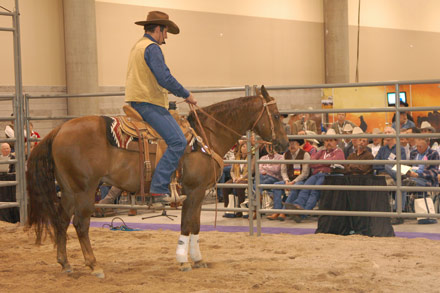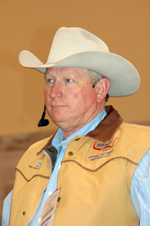Cattle Handling Demonstration
 Curt Pate
Curt Pate
PHOENIX, Ariz. (Jan. 28, 2009) — How many cattle producers invest time in training their cattle to handle better? Texas A&M University Extension Specialist Ron Gill says many if not most producers wouldn’t even think of it. However, during the 2009 Cattle Industry Convention’s Cattlemen’s College Wednesday, Gill said the cattle work easier throughout their lifetimes if exposed to low-stress handling techniques at an early age.
In the long run, he added, producers themselves could benefit from greater ease of handling, greater efficiency and better relationships with employees or family help.
“Wouldn’t it be better if, after working cattle together, you could walk away hand-in-hand with your spouse,” Gill asked, “instead of running after her as she speeds away in the pickup?”
 Ron GillAlong with South Dakota rancher and stockmanship clinician Curt Pate, Gill offered a demonstration of low-stress cattle handling techniques. Gill said the techniques take advantage of animals’ natural instincts, and can actually make the job more enjoyable while enhancing cattle productivity and value.
Ron GillAlong with South Dakota rancher and stockmanship clinician Curt Pate, Gill offered a demonstration of low-stress cattle handling techniques. Gill said the techniques take advantage of animals’ natural instincts, and can actually make the job more enjoyable while enhancing cattle productivity and value.
“A cow wants to see you. She wants to be with other cattle. When driven, she’ll want to circle around you. When put in a pen, she usually wants to go back the way she came,” Gill explained. “But you can use all of that to your advantage. Just remember that she can only think about one thing at a time.”
Gill and Pate shared commentary while working a set of calves through a series of pens and a narrow alley, simulating a working situation. They stressed the importance of working from beside or in front of animals, applying and releasing pressure to create movement and control its direction.
“Beef Quality Assurance is not just about meds,” Pate stated. “It includes handling cattle in a way that improves their performance and profitability. Slow down. Take some time to learn how to position yourself, approach from the right angle and understand when to back off. Eventually you’ll find you’re working cattle smoother and faster, while keeping the cattle quiet.”
Pate and Gill suggested working with replacement heifers when they are kept close at hand, during development, to make them accustomed to low-stress handling methods.
Editor’s Note: This article was written under contract or by staff of Angus Productions Inc. (API), which claims copyright to this article. It may not be published or distributed without the express permission of Angus Productions Inc. To request reprint permission and guidelines, contact Shauna Rose Hermel, editor, at (816) 383-5270.

